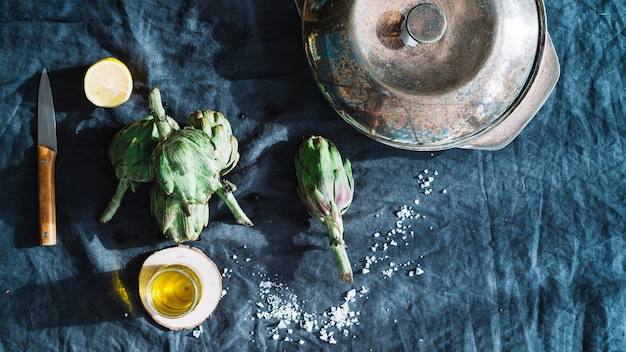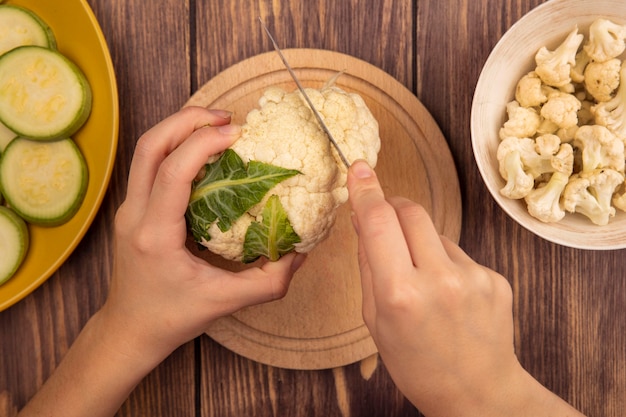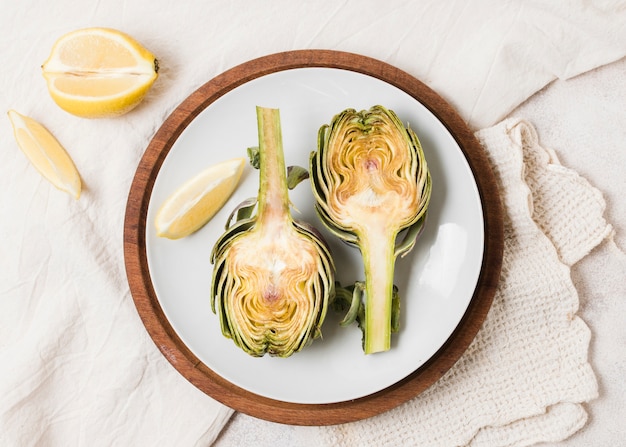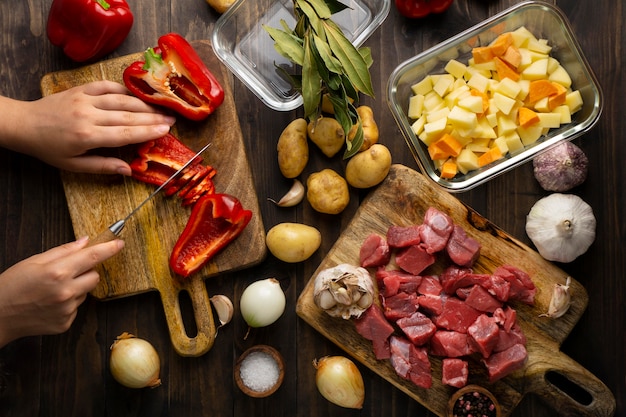Let's be honest, artichokes can seem a bit daunting at first. Those spiky leaves and that strange, almost alien heart can make you think, "How on earth do I eat this thing?" But trust me, once you crack the code, you'll be singing the praises of these delicious and versatile vegetables. It's a real love story, I tell you!
I remember the first time I encountered artichokes. It was at a friend's dinner party, and they served them as a side dish. I was completely lost - how do you even begin to tackle this prickly beast? I nibbled on a leaf here, a bit of the heart there, but honestly, I didn't quite get it. Then, my friend, bless her heart, showed me the proper way to eat them, and everything changed. The artichoke transformed from an intimidating alien creature into a delicious, satisfying, and surprisingly versatile ingredient.
So, I'm going to take you on a journey, a journey into the wonderful world of artichokes. We'll explore different types, discover how to cook them (you'll be a pro in no time!), and most importantly, learn how to enjoy them to the fullest. And trust me, there are many ways to enjoy them.
(Part 1) All About Artichokes: Unveiling the Mysteries

Types of Artichokes: Globe vs. Jerusalem
Let's start with the basics. There are two main types of artichokes, and they're not as closely related as you might think: globe artichokes and Jerusalem artichokes.
Globe artichokes are the ones you're probably most familiar with. They have a large, bulbous head with prickly leaves and a fleshy heart. You can find them in grocery stores year-round, but they're at their peak during the spring and summer months. You'll often find them with the stems still attached, which can be used in some recipes.
- Green Globe Artichokes: This is the most common type of artichoke you'll find. They have a slightly sweet and nutty flavour and are firm to the touch.
- Purple Globe Artichokes: These have a more intense flavour with a slightly bitter edge. They also have a beautiful purple colour that adds visual appeal to any dish.
Jerusalem artichokes are actually a type of sunflower, not an artichoke at all! They have a more subtle, slightly sweet flavour with a hint of nuttiness and are often used in soups, stews, and salads. Their texture is also different, resembling a potato.
Choosing the Perfect Artichokes: Tips for Success
So, you're ready to buy some artichokes. Here's what to look for to ensure you get the best ones:
- Freshness: Look for artichokes that are firm and heavy for their size. The leaves should be tightly closed, and the base should be firm to the touch. A slightly firm artichoke means it's fresh and ready to be cooked.
- No Bruising: Avoid artichokes that have any bruises or soft spots. These could indicate that they've been mishandled and might not be as flavorful.
- Avoid Overly Opened: Make sure the leaves are not overly opened. If the leaves are widely spread, the artichoke may be past its prime and less flavorful.
If you're not sure how to pick the right artichokes, ask your local greengrocer. They'll be happy to give you some tips and help you find the freshest, most delicious artichokes.
(Part 2) Preparing Artichokes: A Step-by-Step Guide

Now, let's get down to business. You've got your artichokes, and now it's time to prepare them for cooking. This part might seem a bit intimidating, but I promise it's easier than you think. It's all about following a few simple steps.
1. Trimming the Artichokes: Removing the Prickles
You'll need a sharp knife and a cutting board for this step. This is where those prickly leaves get tamed.
- Cut off the top: Remove the top inch or two of the artichoke, including the pointy leaves. This part is usually tough and not very pleasant to eat.
- Remove the outer leaves: Discard the tough outer leaves. You can usually tell by the colour and texture; the tough ones are darker and have a more leathery texture. You can also use the tough outer leaves to create a delicious artichoke broth for soups or sauces.
- Trim the base: Cut off the bottom part of the artichoke where it was attached to the stem. This part can be tough and fibrous.
2. Removing the Choke: The Hairy Menace
The "choke" is a hairy, fuzzy part at the base of the heart, and it's definitely not something you want to eat! This is the part that can make people shy away from artichokes, but it's easy to remove.
- Use a spoon: Use a teaspoon to gently scoop out the choke. If you find it difficult to remove, you can also use a small, sharp knife to carefully cut it away.
3. Optional: Lemon Juice Treatment: Preventing Browning
This is a great trick to prevent the artichoke from browning. It's especially useful if you're preparing them in advance.
- Cut the artichoke in half: Cut the artichoke in half lengthwise. This will expose the cut surfaces to the lemon juice.
- Rub with lemon juice: Rub the cut surfaces with lemon juice. The citric acid in the lemon juice will help prevent the artichoke from browning.
4. Steaming, Boiling, or Roasting? Choosing Your Cooking Method
Now you're ready to cook! Artichokes can be steamed, boiled, or roasted, each method offering a slightly different flavour and texture. We'll explore each method in detail in the next section.
(Part 3) cooking artichokes: Three Ways to Perfection

1. Steaming: The Classic Method for Tender Artichokes
This is the most common method for cooking artichokes, and it's pretty foolproof. Steaming helps preserve the artichoke's natural flavor and texture.
- Use a steamer basket: Place your prepared artichokes in a steamer basket.
- Add water to the pot: Add about an inch of water to the bottom of the pot.
- Bring to a boil: Bring the water to a boil, then reduce the heat to a simmer.
- Steam until tender: Steam the artichokes for about 25-35 minutes, or until the leaves are tender. You can test them by pulling off a leaf. It should pull off easily without much resistance.
Tip: Add a squeeze of lemon juice to the water for added flavour. This will also help prevent the artichoke from browning while it's steaming.
2. Boiling: A Quick and Easy Option for a Simple Approach
If you're short on time, boiling is a great alternative to steaming. It's a simple and efficient method for cooking artichokes.
- Fill a pot with water: Fill a large pot with water.
- Add lemon juice: Add a squeeze of lemon juice to the water.
- Bring to a boil: Bring the water to a boil, then add the artichokes.
- Boil until tender: Boil the artichokes for about 20-25 minutes, or until the leaves are tender. You can test them by pulling off a leaf as mentioned before.
Tip: Add a pinch of salt to the water for flavour. This will also help to season the artichokes as they cook.
3. Roasting: For a Hearty, Flavorful Treat that Enhances the Natural Flavors
Roasting artichokes brings out a deeper, more intense flavour. It's perfect for creating a side dish or even a main course, especially if you're looking for a more robust flavour.
- Preheat the oven: Preheat your oven to 400°F (200°C).
- Drizzle with olive oil: Drizzle the prepared artichokes with olive oil. This will help to tenderize the artichokes and add a rich flavour.
- Season with salt and pepper: Season with salt and pepper to taste. You can also add other herbs and spices for added flavour.
- Roast until tender: Roast the artichokes for about 30-40 minutes, or until the leaves are tender. You can check for tenderness by pulling off a leaf.
Tip: Add other herbs and spices for added flavour, like garlic, rosemary, or thyme. These herbs pair beautifully with the artichoke's flavour.
(Part 4) Eating Artichokes: A culinary adventure with Every Leaf
Now, for the fun part! You've cooked your artichokes to perfection, and it's time to enjoy them. Eating artichokes is an experience in itself, involving a little bit of technique and a lot of deliciousness.
1. Dipping and Dunking: The Classic Artichokes Eating Technique
Here's the classic way to eat artichokes. It's a bit of a ritual, but once you get the hang of it, it's quite enjoyable.
- Pull off a leaf: Gently pull off a leaf from the artichoke. The leaves should pull off easily if they are cooked properly.
- Dip the base: Dip the base of the leaf into your chosen dipping sauce. This is where the flavour really comes in.
- Scrape with your teeth: Gently scrape the soft part of the leaf with your teeth, working from the base to the tip. This is where the deliciousness lies.
- Discard the leaf: Discard the leaf once you've finished eating the soft part. There's no need to eat the tough part of the leaf.
Tip: Don't eat the tough part of the leaf. It's not very pleasant! Just focus on the tender, delicious part at the base of each leaf.
2. The Heart of the Matter: The Best Part of the Artichokes
Once you've finished with the leaves, you're left with the heart of the artichoke. This is the most delicious part! It's the heart of the artichoke, literally and figuratively.
- Cut the heart: Cut the heart into smaller pieces. This will make it easier to eat and enjoy.
- Eat with your fork: Enjoy the heart with your fork, dipping it into your chosen sauce. This is the time to really savor the flavours.
3. Dipping Sauces: A Delicious Dilemma for All Tastes
What to dip your artichokes in? It's a delightful dilemma! The right dipping sauce can elevate the artichoke experience to a whole new level.
- Classic Choices: Mayonnaise, garlic aioli, lemon butter. These are timeless classics that pair beautifully with artichokes.
- Get Creative: Try dips like pesto, chimichurri, or even hummus. These bold flavours add a unique twist to the artichoke experience.
- Sweet and Savory: For a twist, try a balsamic glaze or a honey mustard sauce. These sauces add a touch of sweetness and complexity to the artichoke flavour.
Experiment and find your perfect artichoke dipping sauce combination! The fun is in discovering what you love best.
(Part 5) Artichokes in the Kitchen: Beyond the Basic
Now, you know the basics, but artichokes can be so much more than a simple side dish. They're incredibly versatile and can be used in all sorts of dishes, adding flavour and texture to every cuisine.
1. Artichokes in Salads: A Refreshing Twist for Every Salad
Add artichokes to your salads for a burst of flavour and texture. Their slightly nutty flavour and tender texture add a unique element to salads.
- Chopped Hearts: Use chopped artichoke hearts for a quick and easy addition. Just toss them into your favorite salad for a flavourful and textural boost.
- Roasted artichoke salad: roast artichokes with herbs and spices, then toss them in a salad with your favourite ingredients. roasted artichokes add a smoky, rich flavour to salads.
2. Artichokes in Soups and Stews: Hearty and Delicious for a Warm Meal
Artichokes add a unique flavour and texture to soups and stews. Their subtle flavour blends beautifully with various soups and stews, adding a layer of complexity and depth.
- Classic french onion soup: Add artichoke hearts to French onion soup for a more complex flavour. The artichoke's nutty flavour complements the sweetness of the onions and the richness of the broth.
- Hearty Vegetable Stew: Use artichoke hearts in a hearty vegetable stew for a more substantial dish. The artichoke adds a delicate flavour and a satisfying texture to the stew.
3. Artichokes in pasta dishes: A Gourmet Touch for Every Pasta Lover
Artichokes pair beautifully with pasta. Their flavour and texture complement pasta perfectly, making for a satisfying and delicious meal.
- Creamy Pesto Pasta: Toss artichoke hearts with creamy pesto pasta for a delicious and satisfying meal. The artichoke's subtle flavour blends beautifully with the pesto's richness and the pasta's texture.
- Seafood Pasta: Add artichoke hearts to your favourite seafood pasta dish for a burst of flavour. The artichoke's flavour complements the seafood perfectly, creating a balanced and harmonious dish.
(Part 6) Artichokes in Other Cultures: A Global Perspective on This Delightful Vegetable
You might be surprised to learn that artichokes are enjoyed all over the world, and they're used in various cuisines in unique and delicious ways. Artichokes are a truly global ingredient, embraced by different cultures for their unique flavour and versatility.
1. Italy: The Artichokes’ Home, Where Tradition Meets Deliciousness
Italy is a real artichoke paradise! They use them in countless dishes, from simple salads to elaborate pasta dishes. Italy has a long and cherished history with artichokes, and they are a staple ingredient in many regional cuisines.
- Carciofi alla Romana: This classic Italian dish features artichoke hearts braised in olive oil, garlic, and herbs. It's a simple yet flavourful dish that showcases the artichoke's natural flavour.
- artichoke pasta: Many regions in Italy have their own variations of artichoke pasta dishes, often featuring other ingredients like pancetta or shrimp. From creamy sauces to light and vibrant dressings, artichokes are a star ingredient in Italian pasta dishes.
2. France: A French Flair for Elegance and Sophistication
french cuisine also features artichokes, often in elegant and refined dishes. Artichokes are a symbol of sophistication in French cuisine, adding a touch of refinement and elegance to dishes.
- Artichoke Soup: French artichoke soup is a creamy and comforting dish, often served with croutons. This soup is a testament to French cuisine's ability to elevate simple ingredients into culinary masterpieces.
- Artichoke Tart: French artichoke tarts are a delicious and elegant appetizer, often featuring a flaky pastry crust. This is a perfect example of French cuisine's emphasis on presentation and visual appeal.
3. Spain: A Spanish Twist for Bold and Flavorful Dishes
Spanish cuisine embraces artichokes in a variety of ways, often incorporating them into tapas and rice dishes. Artichokes are a common ingredient in Spanish cuisine, adding their unique flavour and texture to various dishes.
- Alcachofas a la Romana: Similar to the Italian dish, this Spanish version is often served with aioli. This is a testament to the commonalities and variations that exist in culinary traditions across different regions.
- Arroz con Alcachofas: This rice dish features artichoke hearts, often alongside other vegetables like peas and green beans. This is a classic Spanish dish that showcases the artichoke's versatility and ability to blend seamlessly with other ingredients.
(Part 7) The Health Benefits of Artichokes: A Deliciously Healthy Choice
Artichokes are not just delicious; they're also packed with nutrients. They're a healthy and flavorful addition to any diet, offering a range of health benefits.
1. Rich in Antioxidants: Fighting Free Radicals for a Healthy Body
Artichokes are a great source of antioxidants, which help protect your body from damage caused by free radicals. These antioxidants play a vital role in maintaining overall health and well-being.
2. Good for Heart Health: Supporting Cardiovascular Health
They're rich in fiber, which can help lower cholesterol levels and improve heart health. Fiber plays a crucial role in maintaining heart health by regulating cholesterol levels and improving blood pressure.
3. Digestive Health Booster: Aiding in Healthy Digestion
Artichokes are a good source of fiber, which is essential for digestive health. Fiber is essential for proper digestion, helping to prevent constipation and promoting regularity.
4. Support Liver Health: Protecting This Vital Organ
Artichokes contain cynarin, a compound that may help protect the liver from damage. Cynarin is a powerful antioxidant that helps to protect the liver from toxins and oxidative stress.
(Part 8) Artichokes: A Culinary Adventure for Every Palate
So, there you have it. Your complete guide to cooking and enjoying delicious artichokes. I hope this journey has inspired you to give them a try, to explore their versatility, and to discover the many ways they can add flavour and joy to your meals.
Remember, it's all about experimentation and finding what you like best. Don't be afraid to try new recipes, to get creative in the kitchen, and to share your artichoke adventures with others. The joy of cooking and eating is about discovering new flavours, experimenting with different ingredients, and sharing those experiences with those you love.
FAQs
| Question | Answer |
|---|---|
| Can I freeze artichokes? | Yes, you can freeze artichokes. It's best to blanch them first by boiling them for 3-5 minutes, then shock them in ice water before freezing. This will help to preserve their texture and flavour. |
| What's the best way to store artichokes? | Store artichokes in the refrigerator for up to 3-4 days. To prevent them from browning, wrap them in plastic wrap. You can also store them in a paper bag to help absorb moisture. |
| Are artichoke hearts cooked before being canned? | Yes, canned artichoke hearts are usually cooked before being canned. This process preserves their flavour and texture for long-term storage. |
| Why are artichokes called Jerusalem artichokes? | Jerusalem artichokes are actually a type of sunflower, not an artichoke at all! The name is thought to come from the Italian word “girasole,” meaning sunflower, which was mispronounced by the English as “Jerusalem.” |
| What is the difference between globe artichokes and Jerusalem artichokes? | Globe artichokes are the type that most people are familiar with, with large, bulbous heads and prickly leaves. They have a slightly sweet and nutty flavour. Jerusalem artichokes are a type of sunflower and have a different flavour and texture, resembling a potato. They have a more subtle, slightly sweet flavour with a hint of nuttiness. |
Everyone is watching

Perfect Rice Every Time: The Ultimate Guide to Cooking Rice
Cooking TipsAs a self-proclaimed foodie, I've always been a bit obsessed with rice. It's the foundation of countless cuisi...

Ultimate Guide to Cooking the Perfect Thanksgiving Turkey
Cooking TipsThanksgiving. Just the word conjures up images of overflowing tables laden with delicious food, the scent of r...

The Ultimate Guide to Cooking Asparagus: Tips, Techniques, and Recipes
Cooking TipsAsparagus. The mere mention of this spring delicacy conjures up images of vibrant green spears, crisp and burs...

Can You Cook Spaghetti with Gasoline? (The Shocking Truth)
Cooking TipsWe've all seen those crazy internet trends. You know, the ones that make you wonder, "Did someone actually try...

Chorizo and Eggs Recipe: The Ultimate Guide
Cooking TipsRight, let’s talk about chorizo and eggs. You know, that classic Spanish dish that's always a winner. It's th...
